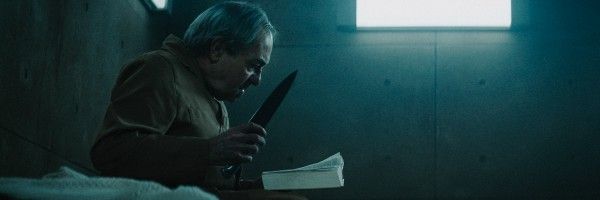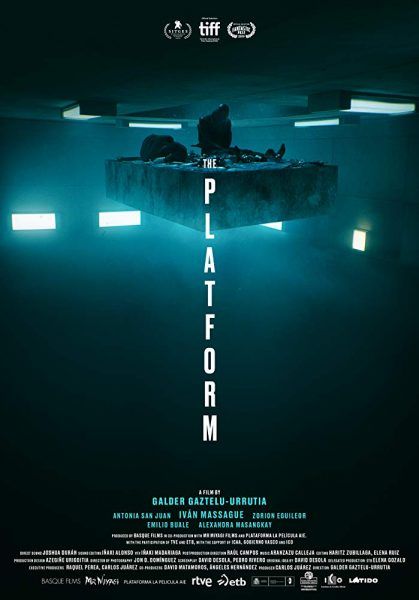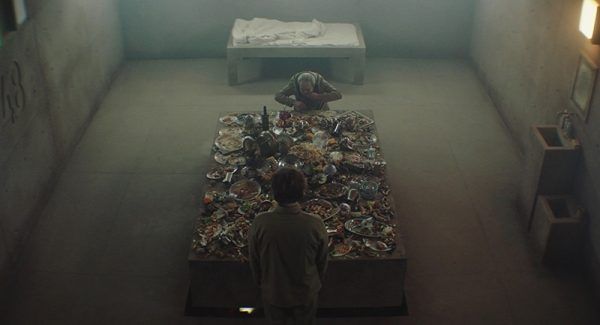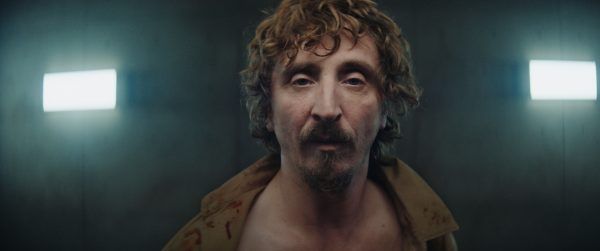I can't get enough of The Platform. It was all I could think about back when I first saw it in September and that continued straight through to the film's March 20th release on Netflix. The Platform features an unforgettable performance from Ivan Massagué as Goreng, a man who agrees to spend six months in a prison-like facility called "The Hole" in exchange for an accredited diploma. It sounds like a reasonable trade at the start, but Goreng quickly comes to realize that the facility's meal delivery system has a devastating effect on the residents.
The Hole is structured vertically with two people per floor. Once a day, a platform makes its way from Floor 1, down to the very bottom. Floor 1 gets first dibs on a beautiful spread of food that includes just about every delicacy imaginable. Then Floor 2 gets Floor 1's leftovers. And then Floor 3 gets what's left of that, and then Floor 4, and so on. Not a bad arrangement for the folks higher up, but just imagine if you're stuck on Floor 100. Making the matter even more nerve-racking is the fact that every 30 days, inmates are moved to a different floor. So you might be living the good life on Floor 6 one month, but then don't get anything to eat on Floor 134 the next.
If you read my review of The Platform, you're already well aware that I think this is a downright incredible directorial debut for Galder Gaztelu-Urrutia. I have no doubt that The Platform will wind up being one of my favorite films of 2020 and I also have all the faith in the world that Gaztelu-Urrutia will continue to deliver big with future projects. There was absolutely no way I was going to let The Platform's big debut pass me by without making the ask to chat with Gaztelu-Urrutia about his experience working on the film, and he was kind enough to indulge me by answering a handful of questions via e-mail. You can check out what he had to say about designing The Hole, what inspired the choices he made while filming the kitchen scenes, the most surprising response to the movie, and more below. We'll also be sharing more from Gaztelu-Urrutia in the spoiler-filled portion of this interview tomorrow!
This is a very ambitious feature debut. Were you 100% confident jumping in and were there any specific parts of the production that you were nervous to film?
GALDER GAZTELU-URRUTIA: Of course. On one hand because a director takes a chance with his first film, on the other, because of the relevance on the topics that the film deals with. Fortunately, I was able to count on the enormous involvement of the entire technical and artistic team.
How’d you go about designing the facility? Did that vision change much from start to the finished film?
GAZTELU-URRUTIA: The process when designing the “platform” was key to getting the most out of every euro out of the budget. Functionally, the entire construction was calculated to the exact millimeter with its modular walls, nooks and crannies in order to be able to shoot 99.9% of the film with cameras on the shoulder, no machinery ... Artistically, the design represents the dehumanized coldness of the Vertical Self-Management Center.
Which scene required the most workshopping?
Please Note: The answer to this question does contain a spoiler.
GAZTELU-URRUTIA: Technically, the scene in which Baharat climbs ... Emotionally, Goreng's psychological collapse following Imoguiri's suicide.
This entire movie looks like a challenge for Ivan. Was there any particular scene that required the most from you as far as making him feel comfortable filming it?
GAZTELU-URRUTIA: Yes, Ivan comes out pretty much in all the scenes and, during filming in six weeks, he had to lose 12 kilos to give credibility to Goreng’s physical and psychological impairment. Imagine how hard it is to play a film that demands so much in itself, while simultaneously going on the most severe diet of your life.
Can you tell us about the creative choice to have scenes with the cooks but without including their dialogue?
GAZTELU-URRUTIA: In a world where many starve, suffer imposed wars, lack medicine … the waste and superficiality of the so-called "first world" is insulting. Aesthetically, the kitchen is represented by cheerful colors and machines that look like toys, but the performances - without dialogue - and the tone of the music tells us that something is not right in the consciousness of those above. The film, nuanced to what many claim, is not a social critique, is a social self-criticism. I surprise myself sometimes by behaving in a ruinous and unsupportive way.
What’s been the most surprising response to the movie?
GAZTELU-URRUTIA: Being so deliberately abstract, leaving countless nuances on the threshold of comprehension, it is understood, as we had planned, in almost every country in which it has been seen ... Inequalities occur everywhere in one way or another. If on that platform, instead of food, we would have placed medicines, the film would have been understood in a similar way.
If you were going into The Hole, what would be your item and why?
GAZTELU-URRUTIA: A very hard copy of Don Quixote. Reading and self-defense on the same object …




